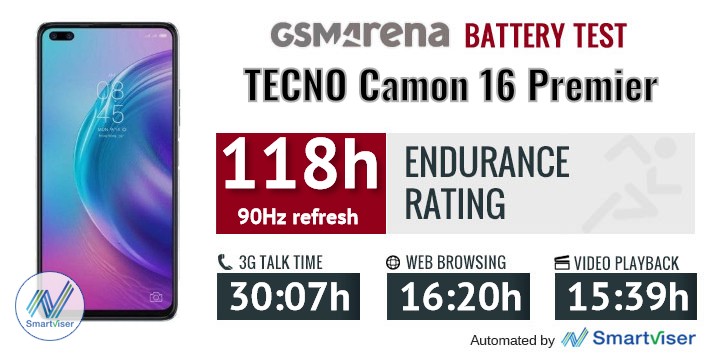Introduction
Tecno is not exactly a globally renowned phone brand. They operate mainly in Africa, Southeast Asia, and Latin America. Tecno phones are, hence, designed in a rather locally-tailored manner and often aim to deliver the best possible value and lowest price point. A quick look at our Tecno page and you will see that they are not sitting still. They've started regularly coming up on our radar, and the Camon 16 Premier is the first Tecno device to officially make it to our grounds for a full review checkup.

One noteworthy consequence of Tecno's aggressive price-subsidizing strategy is the high number of pre-loaded apps and various ads, baked right into their phone's OS. That, unfortunately, tends to be one aspect that instantly stands-out when looking at Tecno devices from a Western standpoint.
On the flip side, however, you can't complain that the their devices lack character and visual distinction.
Tecno's parent-company, Transsion, is not very well know to end-users by its name. Still, many consumers in the markets we mentioned will recognize at least one brand in their portfolio which also includes Infinix and Itel. For instance, the three brands counted together put Transsion group at the sixth spot among smartphone manufacturers in India just a year ago, just to put things into perspective.
With the introductions out of the way, the Tecno Camon 16 Premier is the latest device in Tecno's lineup. On paper, it seems to offer amazing value for its modest MSRP of about EUR 230 ($300). A large, last 90Hz display, four cameras, including a 64MP Quad-Bayer main snapper, with 4K video capture support and EIS, two selfie snappers, one of which also a Quad-Bayer unit, a respectable MediaTek G90T chipset, with 8GB of RAM and 128GB of expandable storage and a sizeable 4,500 mAh battery, even complete with fast 33W charging.
Tecno Camon 16 Premier
- Body: 170.6x77.2x9.1mm, 203g; Plastic body; Colors: Glacial Silver.
- Display: 6.90" IPS LCD, 1080x2340px resolution, 19.5:9 aspect ratio, 374ppi; HDR10+, 90Hz refresh rate.
- Chipset: Mediatek MT6785 Helio G90T (12 nm): Octa-core (2x2.05 GHz Cortex-A76 & 6x2.0 GHz Cortex-A55); Mali-G76 MC4.
- Memory: 128GB 8GB RAM; microSDXC (dedicated slot).
- OS/Software: Android 10, HIOS 6.0.
- Rear camera: Wide (main): 64 MP, f/1.9, 26mm (wide), 1/1.73", 0.8µm, PDAF, Sony IMX686; Ultra wide angle: 8 MP, f/2.3, 119-degree (ultrawide), 1/4.0", 1.12µm;, autofocus, GalaxyCore GC8034; Depth: 2 MP, f/2.4, 1.75µm, GalaxyCore GC02M1B (depth); Low-light: 2 MP, f/2.4, 2.8µm, GalaxyCore GC20A3 (dedicated video camera); Penta-LED flash, panorama, HDR.
- Front camera: Wide (main): 48 MP, f/2.2, 23mm (wide), 1/2.0", 0.8µm; Ultra wide angle: 8 MP, f/2.2, 105-degree (ultrawide), 1/4.0", 1.12µm; Dual-LED flash, HDR.
- Video capture: Rear camera: 4K@30fps, 1080p@30fps, 720p@960fps, gyro-EIS; Front camera: 1080p@30fps.
- Battery: 4500mAh; Fast charging 33W, 70% in 30 min (advertised).
- Misc: Fingerprint (side-mounted), accelerometer, proximity, compass; FM radio.
If all of this sounds incredibly familiar to you, it should. Minor design differences aside, the Tecno Camon 16 Premier is almost a carbon copy of the Infinix Zero 8. A phone which we also recently put through our rigorous review process.
Just because Transsion and its subsidiaries, like Tecno have managed to carve themselves a nifty little niche, doesn't mean that they are universally beloved and free of controversy. On the contrary. After publishing our Infinix Zero 8 review and reading many of your comments and opinions, it seems that many users don't hold some of the company's practices in high regard. Especially the high volume of ads and sponsored content meant to subsidize devices and bring down costs.
For better or worse, that's the reality with the Tecno Camon 16 Premier, as well. Sure, there are certain differences between the Camon 16 and the Infinix Zero 8. But, overall, even on a software level, the two are nearly identical. Hence, you can expect us to frequently reference the Infinix Zero 8 review as we go along.
Unboxing
Straight off the gate, our first reference has to do with the retail box and accessory package of the Tecno Camon 16 Premier. Looking at it, next to the Infinix Zero 8, it is almost like both came out of the same factory. In fact, that might actually be true. Granted, the graphics on top of the box of the Camon 16 are nowhere near as eye-catching as those on the Infinix Zero 8. In fact, that's merely an extension to the fact that the Camon 16 Premier has a slightly tamer and less-distinct design than its sibling.

The box itself is still a sturdy, two-piece design, complete with a secure cradle, made from plastic, on the inside. No complaints there. In terms of accessories, you get a wall charger, rated at 5V@3A and 10V@3.3A, which is how the Camon 16 Premier gets its 33W of charging. Alongside that, a USB Type-A to Type-C cable, with a rigid rugged finish and orange accents on the connectors.
Also in the box - a pair of earbuds, complete with a microphone and the company branding. Nothing too spectacular in terms of quality, but solid enough for a free add-on. Same goes for the transparent plastic case, included in the box. Slightly hidden alongside leaflets, there is also a screen protector. It's also nothing particularly special, just a soft one.
Overall, this is the exact same accessory package that we saw on the Infinix Zero 8 and this is hardly a complaint. On the contrary, there is a lot of added value here. In fact, everything a new user might need to get up and running straight out the gate with the Tecno Camon 16 Premier.
Design and bill of materials
One of the bit things the Infinix Zero 8 has going for it is the distinct design. Especially around the back, with its rotated square camera module and two-tone geometric pattern. Well, the Tecno Camon 16 Premier isn't nearly as striking or memorable in the looks department. That's perfectly fine, though, since there is more than enough room on the market for both eye-catching and more classic-looking handsets.

In fairness to the Tecno design team, the back panel on the Camon 16 Premier is anything but bland, even if it has a slightly tamer look. Tecno themselves describe the surface as "metallic-like", offering a "visual cooling sense" and also liken it to "a glace of sunshine shining on the glacier".
While metal would definitely not be our first association, Tecno is on to something with that glacier analogy. The back panel has a soft color, shifting from ice-blue to soft green shades, depending on how light hits it. Thanks to clever use of layering, it also conveys a sense of depth. We actually like the look quite a bit. It even has a certain premium look to it.

Once you actually hold the Camon 16 Premier though, the task of masking its budget nature becomes significantly more difficult. In keeping with what we expect from a handset around the EUR 250 mark, the back panel is plastic, and so is the middle frame.

The glossy finish on both tends to retain a lot of smudges easily. The back panel also has a bit of flex to it, in part facilitated by the existence of a small internal gap between the 4,500 mAh battery pack and the back panel. Again, like the choice of materials, this is something fairly common in this price segment, which we will not hold against the Camon 16 Premier.

On a more positive note, the Camon 16 Premier feels sturdy and is well put together. Despite that flex in the back panel, the phone feels surprisingly and reassuringly dense. It is a bit bottom-heavy, in terms of weight distribution.
It is worth pointing out that the Tecno Camon 16 Premier is both slightly taller and wider than the Infinix Zero 8. A difference that is very, very hard to catch in person, but one that indicates that these are more than simple re-brands of the same hardware.

The front of the phone manages to pull off a rather modern look. Bezels surrounding the 6.9-inch IPS display are reasonably-sized. The bottom chin is just a bit thicker, presumably to house a more budget-friendly and easier to manufacture display driver board, that does not require some extra wrap-around setup. Even so, the Camon 16 Premier manages to punch above its price category.

The double-wide selfie camera punch hole is a bit on the bigger side. At least it is not weirdly off-center or too close to either of the edges.
More importantly, the presence of the punch hole is integrated into the UI well. The clock and the notification icons are perfectly vertically aligned. The notch is also incorporated through nifty wallpapers and animations. Most notably, switching between the main and the selfie cameras triggers a cool ring animation effect. It is all tied together really well.
Controls, connectivity and sensors
The Camon 16 Premier has two separate volume buttons, instead of a single volume rocker as we saw on the Infinix Zero 8. Also unlike the rather "mushy" volume rocker on the Infinix, the pair of buttons on the Camon 16 Premier actually feel decent, if not, amazing, in terms of tactile feedback. We will count that as an improvement.

Overall, controls on the Camon 16 Premier are straight-forward and well laid-out. You get a nice power button and capacitive fingerprint reader combo on the right-hand side. It is conveniently located height-wise and offers satisfying tactile feedback and is easy to feel-around thanks to being placed in a recessed spot.
The fingerprint reader is snappy and accurate. It is also always-on.

All the other controls are positioned on the bottom bezel. These include a trusty 3.5mm audio jack, Type-C port, with just a basic USB 2.0 interface behind it, but still, one that includes USB host support.
The single speaker on the Camon 16 Premier is also here. There is, unfortunately, no stereo setup, not even a hybrid one.

The MediaTek Helio G90T is hardly a powerhouse but is still perfectly modern in connectivity options. Our Tecno Camon 16 Premier review unit has two nano SIM slots, which can both operate in simultaneous 4G mode - dual 4G VoLTE and 4G data. Advanced network features like IMS (VoLTE\ViLTE\VoWi-Fi) are also supported.
The Helio G90T is equipped with a Cat-12 4G LTE WorldMode modem with 3x CA and 4x4 MIMO and 256QAM. Compared to the Infinix Zero 8, the Camon 16 Premier seems to offer slightly wider 3G band support. The fairly spacious SIM tray also has a dedicated slot for a microSD memory card.

For local connectivity, the Camon 16 Premier gets to enjoy Wi-Fi ac, Bluetooth 5.0, and an FM radio receiver. GPS is also naturally on board. All basic sensors are covered too: G-sensor, e-compass, luminance sensor, proximity, and a gyroscope.
6.9-inch, 90Hz, LCD display
The display is one of the key selling points of the Tecno Camon 16 Premier. And rightfully so as it looks mightily impressive in this price range with its 90Hz refresh rate. The exact same is also true for the panel on the Infinix Zero 8. However, that one ended-up disappointing us in a few ways. So are the two phones using the same panel?

Given all of the similarities thus far, an affirmative answer would be a no-brainer. However, the first shadow of doubt was cast by the fact that the Camon 16 Premier markets its display diagonal as 6.9-inches, while the Infinix Zero 8 insists on using the exact 6.85-inch number. That could very well be attributed to rounding. However, the slight difference in overall body size of the two is worth bringing up once again.
After looking at the performance of the two panels, we are now fairly convinced that the Camon 16 Premier uses a slightly different part. It might be the exact same size, but just from a different vendor. Either way, performance is notably different in a few important ways.

Let's start with that eye-catching 90Hz refresh rate. Generally, the jump to 90Hz refresh rate makes a noticeable difference in smoothness, both for gaming and daily use. However, the current state of high refresh rate tech from both a hardware quality and software execution perspective is not that simple and clear-cut.
One of the major complaints we had with the Infinix Zero 8 and its display is the sluggish pixel response time, which leads to a lot of fringing, ghosting and text-smearing, while scrolling. This is definitely present on the Camon 16 Premier, as well, but a lot less pronounced.
Unfortunately, short of rigging-up a chase camera, there is no feasible way for us to compare the two quantifiably. Still, just by using them side by side, it instantly became clear that the Camon 16 Premier maintains a noticeably better clarity at both 90Hz and 60Hz.
However, unfortunately, the Camon 16 Premier display falls behind the one inside the Infinix Zero 8 in most other regards. Ones, which are better quantifiable like maximum brightness.
| Display test | 100% brightness | ||
| Black, | White, | ||
| 0.486 | 640 | 1317:1 | |
| 0.475 | 631 | 1328:1 | |
| 0.395 | 581 | 1471:1 | |
| 0.42 | 575 | 1369:1 | |
| 0.501 | 515 | 1028:1 | |
| 0.384 | 491 | 1279:1 | |
| 0.317 | 477 | 1505:1 | |
| 0.311 | 473 | 1521:1 | |
| 0 | 466 | ∞ | |
| 0.425 | 461 | 1085:1 | |
| 0.347 | 460 | 1326:1 | |
| 0.343 | 451 | 1315:1 | |
| 0.206 | 450 | 2184:1 | |
| 0.253 | 426 | 1684:1 | |
| 0.303 | 421 | 1389:1 | |
| 0.317 | 408 | 1287:1 | |
| 0.211 | 400 | 1896:1 | |
| 0.298 | 370 | 1242:1 | |
| 0.202 | 328 | 1624:1 | |
Both phones have similar idiosyncrasies with their brightness levels. Notably, while in some apps, they refuse to push the panels to their absolute maximum for some reason. Even after working around that issue, though, the absolute maximum brightness, we measured on the Camon 16 Premier was 400 nits. A number that is not particularly impressive in itself, but also one that is a good 50 nits lower than what the Infinix Zero 8 managed.
The Camon 16 Premier is hard to properly see outdoors. Honestly, we struggled while doing our usual round for colecting camera test shots.

Moving on to colors, just like the Infinix Zero 8, the Camon 16 Premier only has one color mode, with a total lack of control over color reproduction. A bit weird, seeing how even the cheapest budget handsets nowadays try to at least offer some control to the user.
Testing in the only color mode results in sub-par color accuracy, with an average deltaE 2000 of 8.9 and a maximum of 14.7. A simple white point adjustment slider could have gone a long way here as whites and grays have a bluish tint.
We also can't help but note that these deltaE 2000 numbers are even worse than the ones we got on the Infinix Zero 8 - 7.6 and a maximum of 13.3.
HDR support adds yet another extra bit of weirdness to the mix. Yes, you read that right, at least on a software level, the Camon 16 Premier reports that it supports both HDR10 and HLG. Another trait it shares with the Infinix Zero 8. This is also backed-up by the fact that the YouTube app did, in fact, allow us to select HDR options in the quality selector.


YouTube HDR options • DRM check
In person, this didn't result in a spectacular effect, though. If the phone does indeed have support to interpret HDR data, it can't really do much to display it properly. We saw minimal actual HDR benefits while watching some shadow-heavy HDR clips, we are familiar with. Even if somehow HDR worked and looked better on the Camon 16 Premier, though, another issue is the Widevine L3 certification. That means that none of the major streaming services with available HDR content, like Netflix and Amazon, will even serve that content to the handset.
Automatic screen refresh rate behavior
With the proliferation of high refresh rate displays throughout the mobile realm, even reaching the budget segments, as seen here, we have started to pay more attention to just how phones handle their refresh rate on a software level. Like many others, Infinix included, Tecno decided to include an auto-refresh-rate option, alongside its toggles for 60Hz and 90Hz. Still, in our testing, the auto-refresh-rate mode never put the display in 90Hz. Not even once.





No app managed to push beyond the 60Hz mark in auto mode
The forced 90Hz mode, however, worked just as expected. All system apps and the downloaded ones ran in sync with the high refresh rate. We have no way of verifying which games hit the 90fps, but there certainly was no framerate cap at 60fps like there is in Auto mode.
We have already seen some solid and clever auto-refresh-rate mode implementations throughout the industry. There is a lot to be gained for one, for sure, properly balancing the benefits of smooth motion, when applicable, while conserving energy automatically, when it makes sense, like video playback. Then again, we have also seen some less-than-ideal approaches to the matter from big-name players, as well.
In what is currently a Wild West situation regarding proper high refresh rate use, we will take our wins wherever we can and appreciate that at least the 60Hz and 90Hz fixed modes on the Camon 16 Premier work as expected.
Battery life
The Tecno Camon 16 Premier is equipped with a pretty sizeable 4,500 mAh battery just like the Infinix Zero 8. The scores it managed to achieve in our proprietary battery endurance test are, unsurprisingly, similar too.
It should be noted that the Tecno managed slightly better times across the board. Not by much, but not entirely dismissible as merely margin of error occurrences due to their consistent nature. Perhaps, there is some piece of bloat on the Infinix Zero 8 which is missing on the Camon 16 Premier and just happens to be wasting battery a bit more behind the scenes. In any case, the difference is not that big anyway.

118 hours at the maximum 90Hz refresh rate are a solid achievement. Drop the refresh rate down to a more comfortable 60Hz, and the numbers start looking even more impressive.

That being said, just like the Infinix Zero 8, the Camon 16 Premier is leaving unused battery life on the table and outright wasting it in its 90Hz mode. That's not a stab at the 90Hz mode, directly, though. It does what it is supposed to do - manually fix the refresh rate at 90Hz regardless of what is currently on screen, like a video player, playing our 24ish fps sample video.
If Auto mode worked as intended, instead of simply behaving as a second 60Hz toggle, we could have theoretically had the best of both worlds here. Especially considering how well the Camon 16 Premier managed to hold its charge while in standby. It is worth noting, though, that its attitude towards notifications while in standby is a bit too aggressive for our taste. The IMs we tried did manage to push a notification through, even if a few minutes late, but many other apps had to wait until we woke the phone, resulting in an avalanche of new notifications. Not ideal, but potentially fixable.

Charging is impressively quick on the Camon 16 Premier. Again, just like it is on its Infinix Zero 8 sibling. We got very similar results for the two, with a zero to 20% charge taming about 18 minutes, with the phone then hitting 50% in about 27 minutes and an impressive 59% at the half-hour mark. Things naturally start slowing down after that, with a full charge taking an hour and twenty-five minutes. That's a slightly different charging curve than what we get on the Infinix Zero 8, though close enough to be within the margin of error. Overall, quite an impressive for a budget phone.
30min charging test (from 0%)
- Oppo Find X2 Pro
95% - Huawei P40 Pro
80% - Galaxy S20 Ultra 5G
64% - OnePlus 8 Pro
63% - Tecno Camon 16 Premier
59% - Apple iPhone 11 Pro Max
50% - Sony Xperia 1 II
46% - Galaxy Note20 Ultra 5G
43%
Time to full charge (from 0%)
- Oppo Find X2 Pro
0:36h - Huawei P40 Pro
0:50h - Galaxy S20 Ultra 5G
0:58h - Galaxy Note20 Ultra 5G
1:23h - Tecno Camon 16 Premier
1:25h - Sony Xperia 1 II
1:51h - Apple iPhone 11 Pro Max
2:00h
Certain little battery extras included in the software are also notably present on the Camon 16 Premier, just like they are on the Infinix Zero 8. Like the ability to toggle a Battery Full chime, so the phone doesn't have to pointlessly stay pinned at 100% and charging for prolonged periods to the detriment of the battery. Also, to the same end - an automatic battery trickle charge function for overnight charging.
Our battery tests were automated thanks to SmartViser, using its viSer App. The endurance rating above denotes how long a single battery charge will last you if you use the Tecno Camon 16 Premier for an hour each of telephony, web browsing, and video playback daily. We've established this usage pattern so that our battery results are comparable across devices in the most common day-to-day tasks. The battery testing procedure is described in detail in case you're interested in the nitty-gritty. You can check out our complete battery test table, where you can see how all of the smartphones we've tested will compare under your own typical use.
Loudspeaker quality
There is only one speaker on the Tecno Camon 16 Premier. That means you only get mono audio. There is no hybrid setup with the earpiece or anything of the sort. At the risk of repeating ourselves yet again, the Infinix Zero 8 is in the exact same boat. In fact, both have rather similar speakers, quality-wise. That is to say - both are largely unimpressive.
Use the Playback controls to listen to the phone sample recordings (best use headphones). We measure the average loudness of the speakers in LUFS. A lower absolute value means a louder sound. A look at the frequency response chart will tell you how far off the ideal "0db" flat line is the reproduction of the bass, treble, and mid frequencies. You can add more phones to compare how they differ. The scores and ratings are not comparable with our older loudspeaker test. Learn more about how we test here.
To be fair, however, an "average" loudness score is still ok. The frequency response curve on the Camon 16 Premier seems to be similar to the Infinix, as well, with, perhaps a bit better handling of lower frequencies. The phone has both a BesLoudness toggle and one labeled as Dirac sound inside its settings menu. The output recorded above was with both features on. Dirac is a reputable name in the audio industry, so we have to wonder just what exactly is going on behind the scenes here. Especially since there are no actual settings, equalizer or otherwise, to go along with the Dirac title. It's just a simple On-Off toggle. A bit odd.
In contrast, the Infinix Zero 8 has a fairly feature-rich DTS equalizer on-board. That one is arguably a bit more useful since you could tune the speaker to be a bit more pleasant to your ears. Or, alternatively, provide it with something like a treble boost, for the sake of clearer dialog, if you do a lot of movie watching. It's something.
Audio output quality
We've recently discontinued our audio output quality test.
The reason for that is that most phones that arrived for testing were already excellent in this regard and whatever difference there was, it was marginal and probably indistinguishable to anything but our lab equipment.
Android 10 with HiOS v7.0 on top
Tecno's custom Android 10 skin goes by the HiOS moniker. The Camon 16 Premier, in particular, is running the latest version 7, as of writing this review. The branch it is on seems to be quite active, since we actually got two update packages during the span on a week, or so. Mostly containing security patches and small visual tweaks.

Despite the vastly different name, the Tecno skin, as seen on the Camon 16 Premier is incredibly similar to the XOS one on the Infinix Zero 8. There are some minor visual differences scattered all over the place, and a few options don't exactly match-up one to one, but for the most part, the two are nearly identical. Which, of course, makes sense from a cost-saving perspective.
From a user standpoint, however, this is a less-than-ideal setup, since XOS is one of the heaviest and busiest skins we have seen in a while and the same is also true for HiOS. On the one hand, it comes chock-full of extra features, which you may or may not appreciate. The Camon 16 Premier has a ludicrous amount of pre-loaded applications, most of which can easily be defined as "bloat". On the other hand, there are advertisements all over the place. So much so that you are constantly bombarded with these from the very first moment you first set-up the phone. Out of the box, the notification bar tends to get filled-up with persistent notifications and ads almost faster than you can get rid of them. Even the app drawer itself features a row of app ads at the top.




Various ads all around the UI
Granted, some of these pre-installed apps are created by Tecno, or rather, its parent company Transsion, since we saw most of these on the Infinix Zero 8, as well. Plus, most do serve a particular purpose. Other third-party ones are more or less launchers and hubs. Instant games, in the sense of web-based gaming experiences are a common sight among the latter. While not necessarily bloat in the traditional sense, these tend to generate an obscene amount of notifications, which is the point at which we start taking issue with them. Some of these notifications are persistent, as well.


Inordinate amount of notifications
Coming hot on the heels of the Infinix Zero 8 review, and having-learned a bit mare about some of Transsion's local market strategy, we are fairly certain that this heavy-handed ad strategy is meant to help subsidize phones as much as possible and bring down the upfront cost to the end-user. We can respect that.
However, if you do decide to go for the Camon 16 Premier, or any other Tecno or Infinix phone, for that matter, be prepared to spend some time and effort uninstalling and de-bloating. Getting rid of some things might even require ADB command line work.
We can somewhat understand and justify third-party app deals. However, the bloat in HiOS extends to some basic features, which is a lot harder to forgive. For instance, the default keyboard prompts the user for quite a few permissions and access to all sorts of information the first time you try to type. Other core parts of the UI do the same too.




Keyboard and other permission request and nagging prompts
Even putting privacy and security concerns aside, this simply makes for a cumbersome experience. The initial setup on the Camon 16 Premier was truly annoying, with prompts and wizards and permissions all over the place. After that, many of the apps we tried launching had some data, access, or account requirements of their own to nag about. Some of these apps install even more bloat and shortcuts on the Zero 8.
In fairness, we there were a few genuinely useful prompts in the mix, like one that automatically tries to categorize newly-installed apps and games and put them in a folder or another one that reminds you to delete APK files once you have installed them. Both, however, sadly lost in the sea of other nonsense pop-ups.

It's an amazingly poor user experience overall. Once HiOS 7 gets properly decluttered, it does become noticeably more usable, though.
Upon successful screen unlock with the fingerprint reader, or face unlock, you will be taken on a homescreen that's basically the same across all launchers - a Google widget, and shortcuts for the most important apps. One thing we will note about face unlock is that it is oddly isolated as a separate app in HiOS 7, with its own shortcut and not otherwise found in the settings menu. Weird!

Face unlock resides in a separate app
The leftmost pane holds cards, which is another word for widgets. There is a ton of those, some of them contain ads, but you can disable those (thankfully).
There is an app drawer if you decided to use one - the strange A-Z orange icon at the bottom. There is a lockscreen "magazine" feature for changing its wallpaper automatically if you are into that sort of thing.




Lock screen • Homescreen • Cards pane • App drawer
The notification shade itself is nothing out of the ordinary. It can fit three rows with six quick launch icons for each row, and right under the icons, you will find the screen brightness slider.
Multitasking is a familiar affair, and the task switcher allows for split-screen mode. Only apps that officially support non-fullscreen operation are listed, though. HiOS does not attempt to force the behavior on other apps. Another similarity between it and XOS.





Notification shade • Quick toggles • Quick toggles • App switcher • Split-screen mode
There are a ton of useful settings such as battery saving options, themes, smart panel, social turbo, gestures, and what not. So many that the top of the Settings menu even features a carousel of settings banners. Kind of an odd choice, which, given the ad-laden state of the rest of the UI, can easily be mistaken for yet another ad spot.




Settings menu and suggestion carousel
In no particular order, here are some of the more standout settings. Just like the Infinix Zero 8, the Tecno Camon 16 Premier has a pair of audio enhancements. Both share the Medatek's "BesLoudness" sound enhancement, which acts like a small, but noticeable volume booster for the loudspeaker. Frankly, we don't know why anyone would want to turn it off, which makes us wonder why even have the toggle.
The same goes for the Dirac toggle. The latter is a well-known and reputable name in audio and smartphone audio enhancement, in particular. However, the perplexing bit is that you get absolutely no option in the Camon 16 Premier. It is just a simple toggle.
In contrast, the Infinix Zero 8 has a rather feature-complete DTS equalizer. Not that it can do any wonders for the single loudspeaker, anyway, but it is a more versatile setup, for sure. That's one small but noteworthy software difference we noticed between the two phones.



BesLoudness and Dirac audio improvements
There are many other features that seem identical across the Infinix XOS skin and Tecno's HiOS, just with a slightly-tweaked UI and a different name. One example is Battery Lab, known as Power Marathon on the Infinix Zero 8. We have to note that Tecno's naming sounds a lot nicer, which is a recurring trend across the UI. The app itself is a battery management hub. It has all of the basics covered, including schedules and settings for killing or limiting the background activity on a per-app basis.




Battery Lab
It is worth noting that it is not the only phone health management hub, included on the Camon 16 Premier, though. There is the Phone Master app, which is also found with the exact same name and interface on the Infinix Zero 8 presumably since it a separate app and not baked into the OS. Though, we did find app-level visual differences between XOS and HiOS, a well. You can use Phone Master to invoke some automatic process-killing activities, for power saving.
The CPU cooler option naturally caught our eye. Turns out, it just offers to close some of the apps that are using more resources at the moment or were doing so a while ago. Which, indeed, should lower overall system temps.



Phone Master
Since we are already on the topic of assistive apps for the phone itself, HiOS has a few other pre-loaded apps, technically also in that category. There is Carlcare, which seems to be dedicated to getting aftersales service for Infinix, itel and Tecno phones including tips, phone and chat support and service center locations. All three brands appear to use a digital warranty, which gets activated the first time you set the device up. Neat!
There is also the self-explanatory Feedback app.





Carlcare and Feedback app
Both of these are also found on the Infinix Zero 8 and seem to be applicable to all Transsion smartphones. Tecno also has Tecno SPOT, which seems to be a bit more targeted. It is a cross between a forum, bulletin board, and a social network and also contains some useful tips and tricks and user guides.






TECHO SPOT app
Overall, even though we would have preferred a more orderly approach, with one single central location for all of these features, we appreciate the extra attention to aftersales support and service.
Speaking of lack of proper organization, just like XOS7, HiOS 7.0 has a surprisingly robust theming engine, but one that is inexplicably split in two. There is a settings menu, which can only set items you already have downloaded or created and a separate Hi Theme app, for all of the actual customizing. Given that Hi Theme seems to look, behave and contain the same things as the XTheme app on the Infinix side, we can only gather that the separate app approach was an easier way to do a quick re-brand.



Themes and wallpaper settings
On the plus side, there is plenty of content to explore in the online repository. Better still, all of it seems to be free for the taking. At least we didn't stumble across a paid item ourselves.






Hi Theme app
There are even more options and apps left in HiOS, but they are far too many to list in this section exhaustively, so we will mention just a few highlights. System navigation is on a classic on-screen button setting, by default. You can, however, opt for familiar gestures instead or leave the buttons and just swap the pack and recent apps controls.




System navigation options
Game Mode is prominently featured on the Camon 16 Premier. It consists of two parts - one is an app, which holds some settings, and detailed statistics on in-game time and usage. More-interesting here is the Parental controls, which allow for strict gaming limits. There is also, a rather clever background resource optimization scheme, which lets you select apps that you want and apps that you don't want the OS to kill and otherwise disable while in-game.








Game Mode options
In order to actually get Game Mode working in a game, you need to have it centrally enabled, either through the above menu or the quick toggle in the notification shade, and then have your game either automatically or manually tagged by the features.

Once all of these are in order, you can swipe from either side of the screen in-game and bring-up a game bar or HUD, if you will. Once again, the features here are self-explanatory. We would have preferred a more numerical indication of current CPU and GPU loads. But, other than that, we don't have a lot to complain about.


Game bar
One extra hidden feature is the ability to map on-screen controls to the volume up and down keys. This works rather well for certain games. It's definitely not on the same level as say, the ROG Phone 3 and its amazing multi-functional AirTrigger controls and extensive mapping software. Even so, it's a rare sight on mainstream smartphones, in general.
Extra points for the Transsion software team for making this available in both XOS and HiOS and really taking inspiration from the top dogs in the mobile gaming niche and putting the extra effort for a surprisingly competent implementation of its own.


MagicButton mapping
Assistive features are abundant in HiOS 7.0, just like they are in the Infinix XOS7. Once again, in part slightly renamed. Smart Panel is a quick menu, which can be summoned by swiping left or right, from the edge of the display, anywhere in the UI. It can house a number of tools, as well as app shortcuts and even a volume slider. Pretty convenient.






Smart Panel options and gestures
And then there is the standard slew of gestures. One of which is double-tap to wake. The Infinix XOS7 has these under an "actions and gestures" menu, while CAMON has gone for the more sophisticated-sounding "Micro intelligence". The Camon 16 Premier also has screen-off gestures, which were missing from the Infinix Zero 8, at the time of its review, with the rest of the gesture options shared between the pair.

Social Turbo is a particularly curious feature. Especially since it resides in the main settings menu, instead of being a separate app, making it something of a low-level, core extra. It contains a set of upgrades for WhatsApp. Things like a beauty filter for the camera, custom icons, and the ability to peek at messages without marking them as read. These are some very app specific oprtions so we can only imagine that this is one example of Infinix catering its offerings to its particular markets and customers.





Social Turbo
The overall market-tailored approach both Infinix and Tecno take to customizing their software features at least partly explains the inclusion of some of the pre-installed apps on the system. Things like Boomplay - an app with a similar look and feel to Spotify, which offers both a free tier for music streaming and a paid subscription.





Boomplay
Same goes for apps like Games Lobby, AHA Games, and Palm Store. Both of the latter are alternative app stores, of sorts. Well, Palm Store is features plenty of deceptive titles and descriptions, often masking ad-heavy and potentially malware-ridden actual APK downloads. We would recommend staying away from it. Plus, you get instantly bombarded with automated app install wizards right as you first launch the stores.





Palm Store
Games Lobby offers a quick way to play HTML browser-based games. Apparently, those are popular in the markets Infinix operates. AHA Games seems to offer a little bit of both - game downloads, as well as "Instant Games". All of this is likely subsidizing the Tecno Camon 16 Premier and bringing down its cost, so we won't be complaining too much.






AHA Games
These should frankly be on the top of your list of apps to instantly uninstall since they are the most vocal when it comes to spamming notifications. Just remember to re-download any apps and games you do need afterwards from a different store, so they can continue to auto-update. There is no real loss in doing so either since the Camon 16 Premier still has a full Google suite of apps installed. This includes the Play Store, as well as basics, like Files and Photos. We were even a bit surprised to see that Chrome is the default web browser.
Pleasantly so, since Tecno could have easily gone for a sponsored deal with any number of odd Android web browsers out there. Sadly, unlike the browser, the default keyboard did not escape some sort of deal, with the KiKa keyboard as the pre-loaded one.




Default Google apps
In yet another odd software-loadout choice, CAMON includes some of its own, in-house developed basic apps in HiOS. More-accurately, these, again, seem to be developed by Transsion and shared among all of its smartphone brands and devices. These often double features, already covered by Google apps. Like the Files app and the default AI Gallery, which is, honestly, not bad at all. It even offers a decent set of basic editing options, and some extra features for cleanup, photo compression and hiding items.




AI Gallery
We don't have anything against these apps, since they both look and work well. The same goes for other core apps that CAMON/Transsion has developed, like the calculator, calendar, clock, notepad, sound recorder, weather, and video player.
There are a few weirder and more out-there first-party additions, as well. T-Graffiti seems similar, though slightly different than the Infinix Magic Line app. At its core, both are AR-based doodling experience for the camera. YoParty can connect multiple devices together to play music in a synchronized manner.




T-Graffiti and YoParty apps
All and all, there is a lot of content inside HiOS 7.0, created and included for different reasons and with various goals. Some extras are definitely more thoughtful than others and seem to work surprisingly well. Game mode was a truly pleasant surprise. Other bits are clearly shoehorned-in for financial reasons. Thankfully, those can be removed. You do need to go into HiOS with the corresponding mindset, though. Once you invest some time into cleaning it up, it can provide a rather pleasant custom Android experience.
Performance and benchmarks
The Tecno Camon 16 Premier is built around the MT6785 Helio G90T chipset. It is a 12nm chip, making it fairly-efficient, which includes a pair of faster 2.05 GHz Cortex-A76 cores and six more Cortex-A55 ones, clocked at up to 2.0 GHz. The Camon 16 premier pairs the chip with 8GB of RAM and 128GB of expandable storage via a dedicated microSD slot.

In the GPU department, we have a Mali-G76 MC4 pushing pixels on to a panel, with a native FullHD+ resolution of 1080 x 2460 pixels. While that does put the GPU in a bit of a strenuous situation, overall, the Helio G90T is one of the more potent chipsets available in the budget smartphone segment.
And, just in case you were wondering, yes, this is the same hardware, as found inside the Infinix Zero 8. Naturally, we are including it in the selection of devices to compare the Camon 16 Premier against in benchmarks. Alongside those, we also picked out a colorful selection of other recent budget chipsets, like the similar Helio G85, G80, and the P35 solutions from MediaTek. You will also see competition like the Snapdragon 665, 720G, 732G, as well as some manufacturer-specific chips, like the Samsung Exynos 850 and the Kirin 810, by HiSilicon. All of these can be had in handsets roughly the budget of the Tecno Camon 16 Premier.
GeekBench 5.1 (single-core)
Higher is better
- Huawei P40 Lite
591 - Redmi Note 9S
570 - Poco X3 NFC
568 - Tecno Camon 16 Premier
532 - Infinix Zero 8
532 - Redmi Note 8 Pro
493 - Xiaomi Redmi 9 (Prime)
362 - Redmi Note 9
361 - Xiaomi Redmi Note 8
315 - Motorola Moto G8 Plus
310 - Infinix S5 Pro
187 - Samsung Galaxy A21s
184
We kick things off with some pure-CPU numbers and GeekBench. The overall trend, set by these results, seems to apply to most of the other synthetic runs too.
As we said, the MediaTek G90T is no chart-topper, but still a decent performer. More than adequate for most users in 2020. An important thing to note in all of these benchmark runs is that the G90T, as implemented inside the Tecno Camon 16 Premier performs as expected. Notably, it matches the results of the Realme 6 and Redmi Note 8 Pro, equipped with the same silicon. And, of course, the Infinix Zero 8, even outpacing it slightly.
Realme appears to be squeezing a bit more performance out of the CPU on average but within a variance only noticeable in synthetic runs and not in real-world use.
GeekBench 5.1 (multi-core)
Higher is better
- Huawei P40 Lite
1862 - Redmi Note 9S
1785 - Poco X3 NFC
1777 - Tecno Camon 16 Premier
1672 - Infinix Zero 8
1663 - Redmi Note 8 Pro
1622 - Motorola Moto G8 Plus
1385 - Xiaomi Redmi Note 8
1339 - Xiaomi Redmi 9 (Prime)
1325 - Redmi Note 9
1292 - Samsung Galaxy A21s
1100 - Infinix S5 Pro
1039
The Snapdragon 720G, the newer 732G, and the Kirin 810 appear to outpace the Helio G90T consistently. Conversely, the Snapdragon 665 seems to lag behind it, and, like common numbering logic suggests, so do the Helio G85, G80. The Exynos 850 seems to fall behind in raw performance. However, it does have efficiency on its side, with its 8nm manufacturing process.
AnTuTu is generally a more-compound benchmark, taking into account things like resolution and memory performance. It is a lot more-favorable towards the MediaTek G90T, in general. However, a high score on the Camon 16 Premier also serves as a good indication that the manufacturer did not skimp-out on any of the memory chips.
AnTuTu 8
Higher is better
- Huawei P40 Lite
325777 - Tecno Camon 16 Premier
283847 - Poco X3 NFC
283750 - Infinix Zero 8
282348 - Redmi Note 8 Pro
279355 - Redmi Note 9S
254000 - Xiaomi Redmi 9 (Prime)
201829 - Redmi Note 9
200414 - Motorola Moto G8 Plus
168699 - Xiaomi Redmi Note 8
161572 - Infinix S5 Pro
117533 - Samsung Galaxy A21s
107157
You don't really buy a budget handset with the intent of getting an ultimate gaming powerhouse. It is perfectly realistic to expect a smooth experience out of most modern Android games, short of the most demanding ones. Current titles are so well-optimized and seamlessly adapt things like rendering details, distance, effects, and even resolution so with the respectable benchmark scores shown here by the Camon 16 Premier and its Mali-G76 MC4 GPU, you can easily expect a smooth experience.
GFX 3.0 Manhattan (1080p offscreen)
Higher is better
- Huawei P40 Lite
53 - Tecno Camon 16 Premier
49 - Infinix Zero 8
49 - Redmi Note 8 Pro
48 - Poco X3 NFC
44 - Redmi Note 9S
42 - Xiaomi Redmi Note 8
19 - Motorola Moto G8 Plus
19 - Samsung Galaxy A21s
16 - Infinix S5 Pro
12
GFX 3.0 Manhattan (onscreen)
Higher is better
- Huawei P40 Lite
49 - Tecno Camon 16 Premier
42 - Infinix Zero 8
42 - Redmi Note 8 Pro
40 - Redmi Note 9S
36 - Poco X3 NFC
33 - Samsung Galaxy A21s
28 - Motorola Moto G8 Plus
18 - Xiaomi Redmi Note 8
16 - Infinix S5 Pro
11
Mind you, rendering at a FullHD+ resolution is still not exactly ideal for this caliber of the chipset. HD offers a lot more headroom. You can see how that is working to aid the on-screen performance of the Samsung Galaxy A21s in these charts. Though even then, its Mali-G52 still falls short in the GPU department.
Of course, just because the Camon 16 Premier has a higher native resolution does not mean that you are forced to render games at it. Most modern game engines and titles will dial-back rendering resolutions automatically by themselves. Alternatively, there are plenty of tools out there to achieve that effect too. Remember, these fps numbers are based on purely synthetic and unrealistic loads.
GFX 3.1 Manhattan (1080p offscreen)
Higher is better
- Huawei P40 Lite
34 - Poco X3 NFC
33 - Tecno Camon 16 Premier
30 - Infinix Zero 8
30 - Redmi Note 9S
30 - Redmi Note 8 Pro
29 - Xiaomi Redmi Note 8
13 - Motorola Moto G8 Plus
13 - Samsung Galaxy A21s
9.4 - Infinix S5 Pro
8.2
GFX 3.1 Manhattan (onscreen)
Higher is better
- Huawei P40 Lite
30 - Poco X3 NFC
27 - Tecno Camon 16 Premier
26 - Infinix Zero 8
26 - Redmi Note 9S
26 - Redmi Note 8 Pro
24 - Samsung Galaxy A21s
19 - Motorola Moto G8 Plus
12 - Xiaomi Redmi Note 8
11 - Infinix S5 Pro
7.3
Ramping up the intensity of these synthetic runs beyond a certain point is, more or less, a pointless exercise on a chipset like the MediaTek G90T. There is only so much performance it can conceivably give. Still, there is at least a bit of curiosity in waiting for these uncomfortably long runs, just to see the final number.
GFX 3.1 Car scene (1080p offscreen)
Higher is better
- Huawei P40 Lite
21 - Poco X3 NFC
19 - Tecno Camon 16 Premier
18 - Infinix Zero 8
18 - Redmi Note 8 Pro
18 - Redmi Note 9S
18 - Motorola Moto G8 Plus
7.1 - Xiaomi Redmi Note 8
7 - Samsung Galaxy A21s
6 - Infinix S5 Pro
3.7
GFX 3.1 Car scene (onscreen)
Higher is better
- Huawei P40 Lite
18 - Poco X3 NFC
16 - Tecno Camon 16 Premier
15 - Infinix Zero 8
15 - Redmi Note 9S
15 - Redmi Note 8 Pro
14 - Samsung Galaxy A21s
11 - Motorola Moto G8 Plus
6.5 - Xiaomi Redmi Note 8
5.9 - Infinix S5 Pro
3.2
Once you get into tougher, modern benchmarks like the Aztek ones, any various bottlenecks start to come into play on the various phones. All of the tested devices hence start scoring a lot closer, showing that these GPU setups really are quite comparable.
Aztek Vulkan High (onscreen)
Higher is better
- Poco X3 NFC
11 - Tecno Camon 16 Premier
10 - Infinix Zero 8
10 - Redmi Note 9S
9.9 - Redmi Note 8 Pro
9.4 - Huawei P40 Lite
8.6 - Samsung Galaxy A21s
6.6 - Motorola Moto G8 Plus
4.1 - Infinix S5 Pro
1.8
Aztek OpenGL ES 3.1 High (onscreen)
Higher is better
- Huawei P40 Lite
12 - Tecno Camon 16 Premier
11 - Infinix Zero 8
11 - Poco X3 NFC
11 - Redmi Note 8 Pro
10 - Redmi Note 9S
10 - Samsung Galaxy A21s
7.1 - Motorola Moto G8 Plus
4.5 - Infinix S5 Pro
2.3
As is usually the case, 3DMark's more granular scores offer a more clear-cut and well-organized way of grading raw performance. Again, the synthetic variances are there, but slim and practically non-observable in real-world use.
3DMark SSE OpenGL ES 3.1 1440p
Higher is better
- Huawei P40 Lite
2818 - Poco X3 NFC
2689 - Infinix Zero 8
2537 - Tecno Camon 16 Premier
2531 - Redmi Note 9S
2494 - Redmi Note 8 Pro
2363 - Motorola Moto G8 Plus
1125 - Samsung Galaxy A21s
888 - Infinix S5 Pro
449
3DMark SSE Vulkan 1440p
Higher is better
- Huawei P40 Lite
2603 - Tecno Camon 16 Premier
2577 - Infinix Zero 8
2556 - Poco X3 NFC
2495 - Redmi Note 8 Pro
2447 - Redmi Note 9S
2357 - Motorola Moto G8 Plus
1037 - Samsung Galaxy A21s
901 - Infinix S5 Pro
614
As expected, the CAMON 16 Premier performs similarly to its Infinix Zero 8 sibling. More importantly, it does perfectly fine for its price bracket. The MediaTek Helio G90T is not a chart-topper, but it is still a modern chip with enough performance to power a smooth experience and adequate, up-to-date connectivity and additional features.
One notable difference between the CAMON and Infinix implementations of this particular hardware setup is that the Camon 16 Premier runs noticeably cooler under load. More-accurately, the Camon 16 Premier does not have the notable heat issue that plagues the Infinix Zero 8.
To be fair, the excess heat on the Infinix Zero 8 does not seem to affect actual performance numbers and only results in a less-comfortable in-hand experience, especially during long gaming sessions. Still, bonus points to Tecno here. Apparently, despite their massive similarities, the Camon 16 Premier and Infinix Zero 8 still have notable differences in their internal design.

In any case, our main recommendation here is still exactly the same as with the Infinix Zero 8. While it is great to see that despite the bloated software experience the custom HiOS and XOS skins both still manage to deliver the expected hardware performance, there is plenty of room for improvement in terms of actual experience. We would like to see the UI and UX get cleaned-up and organized at least a bit more. We realize that a certain amount of bloat might be inevitable to maintain the company's current, subsidized budget price points. Even so, if the integration is done better, the otherwise decent hardware performance can actually be translated to a snappy, smooth, and less-cumbersome Android experience.
Versatile quad-camera setup
Comparing the Tecno Camon 16 Premier to the Infinix Zero 8 is a reoccurring theme in this review, to say the least. The quad camera setup is just one more thing that is shared between the two. However, credit where credit is due, Tecno has clearly done a much better job at describing its cameras in detail. Something that proved to be a massive and frankly unnecessary issue with the Infinix Zero 8.

Tecno's PR department has even gone one step beyond by giving marketing-friendly names for each of the four cameras on the Camon 16 Premier. First up, we have the main 64MP "Ultra Clear Lens", which, granted, might be a case of poor translation. This uses a Quad Bayer Sony IMX686 sensor, with 0.8µm pixels and an f/1.89, 79.8-degree lens in front of it. Technically, a 6-piece lens design.
Then we have an 8MP ultrawide camera, called "Anti-distortion Super Wide Angle/Macro Shot Lens". That uses a bit of an obscure GalaxyCore GC8034 sensor, with 1.12µm pixels and a 5-piece, 119-degree FOV, f/2.25 lens. It actually has autofocus, which is kind of a rarity, especially on a budget device.
Finally, the Camon 16 Premier has two additional 2MP cameras. One is called a "Depth Control Lens" - a GalaxyCore GC02M1B, 1.75µm, f/2.4, 3-piece, 88.9-degree lens. It is a monochromatic unit meant for depth information, like the name suggests.
The final 2MP camera is probably the most mysterious out of the bunch. Its "1080p Ultra Night Video-shoot Lens" title is quite descriptive. Apparently, it is a dedicated camera for capturing low-light video. Makes sense, considering its GalaxyCore GC20A3 RGB sensor has big 2.8µm pixels and is paired with a fairly-bright f/1.8, 5-piece, 73.9-degree lens.
In term of additional camera features, the Camon 1 Premier boasts 5-led flash design. These are not dual-tone or anything too fancy, so we can't say that they make too much of a difference to actual photo quality, with any confidence.
Before we get to actual quality analysis, though, we need to take a look at the camera app. It is straight-forward and fairly well-organized. The "AI" part of the software comes down to scene recognition, as signified by the small icon on the viewfinder. It's far from the most sophisticated system we have encountered, but it seems to do a fairly good job identifying the contents of the shot.


Camera UI
It should hardly come as a surprise that the UI here is quite similar to the one on the Infinix Zero 8 and its XOS7. That being said, during the course of writing this review, our Camon 16 Premier unit actually got an update that tweaked some of the iconography and animations within the app, making it a bit more-distinct. Nothing major, but worth noting.


Updated camera UI
We appreciate that things like the 64MP mode toggle and the HDR mode selector are front stage and center as quick toggles, instead of being buried in settings. Naturally, some of the toggles change according to the currently active camera. The ultrawide, for example, does not have 64MP mode. The same is true for the equally well-organized settings menu, which changed depending on which mode you launch it from.






Camera app settings
Camera performance on the Camon 16 Premier is somewhat of a disappointment overall. The main issue being that it fails to perform quite on the same level as its Infinix Zero 8 sibling. A real odd situation, given the hardware similarities between the two, including camera setup, as well as the unfortunate accent on camera, brought about by the "Camon" naming convention.
To be fair, the difference between the two is not massive in most cases. Honestly, if this review didn't come hot on the heels of the Infinix Zero 8 one, we might have even been a bit more lenient towards the Camon 16 Premier, mostly on the grounds of its budget price tag. However, there is no excuse for some comparative downgrades in quality, especially on the main 64MP, Quad Bayer Sony IMX686 camera, which has already proven its salt time and time again.
Looking at shots taken in the camera's default 16MP mode, in auto AI camera mode, we are left quite unimpressed.






Tecno Camon 16 Premier main 16MP camera samples
Shots are soft and very grainy. And it's not just uniform areas, like the sky or grass that are suffering. The issue is visible all throughout the frame. Detail in finer patterns is frequently lost. At the same time, the algorithm sometimes makes up some non-existent geometrical shapes of its own. Dynamic range is a bit narrow, too. Colors are a bit more desaturated than what we would have liked to see.
All of these are issues also present on the Infinix Zero 8. However, the Camon 16 Premier seems to be experiencing them even more. The sharpening algorithm is noticeably more heavy-handed, in comparison and even more details tend to get lost in the shadows. Apparently, despite their common parent company and extremely similar hardware and software, Tecno and Infinix have decided not to share came algorithms outright. A decision that seems to be ironically detrimental to the Camon line, rather than the other way around. Or perhaps company engineers decided to try and give the Camon 16 Premier a bit of "extra-pop", for lack of a better term and unfortunately ended-up furthering some issues and imperfections.
HDR does have some positive effects on the main camera, recovering crushed details in the shadows. However, Auto HDR is not consistent enough and doesn't always kick-in when needed. Here are some shots from the main camera, with HDR forced to OFF.






Tecno Camon 16 Premier main 16MP camera samples, NO HDR
Moving on to the 8MP Ultrawide camera, we find yet another unfortunate similarity between the Camon 16 Premier and the Infinix Zero 8 - both are plagued by major inconsistency. And we're not talking about things like resolved detail, dynamic range or sharpness, which are always going to be worse on an ultrawide snapper. Colors reproduction is vastly different. Honestly, we kind of like the colors on the ultrawide cam better, since the main one tends to make things a bit too warm, almost applying a yellow tint. The main point, however, is that there is room for improvement and a more unified look and feel is one thing that could use work.






Tecno Camon 16 Premier ultrawide 8MP camera samples
Aside from these consistency issues, the ultrawide camera suffers from the usual plaits of ultrawide snappers - dynamic range is even more limited, noise is abundant and there is noticeable softness around the edges.
HDR helps noticeably more here than it did for the main camera. Even its auto triggering mode is a bit more accurate. Here are some shots with no HDR.






Tecno Camon 16 Premier ultrawide 8MP camera samples, no HDR
While having autofocus on the ultrawide is a rarity we appreciate and one that gives it an extra layer of versatility, as a macro-shooter, it can often misbehave on the Camon 16 Premier. Focus-hinting is a bit too frequent for our taste and the algorithm doesn't always get the focus right. The problem is not that severe in good light, but get really, really bad in low-light conditions. To the point of making the ultrawide nearly unusable. But, more on that in the low-light section.
By default, ultrawide shots go through an algorithm that crops away some of the frame and does its best to straighten-out the objects the in frame. The one on the Camon 16 Premier does a fairly competent job, which we can appreciate from these ultrawide samples, taken with the correction toggled off.






Tecno Camon 16 Premier ultrawide 8MP camera samples, no distortion correction
Although there is no dedicated telephoto camera on the Camon 16 Premier, it still offers a 2x toggle, alongside the regular digital zoom. That's not to say that the 2x isn't digital. It is, entirely so. There is some upscaling involved, as well, since the shots still come out in 16MP.
The automatically-applied amount of sharpening is a bit more heavy-handed in zoom mode, though, which might not be to everybody's taste. Even so, the results don't look too bad. As long as you don't pixel-peep, they are perfectly usable.






Tecno Camon 16 Premier 2x zoom 16MP camera samples
You can go as high as 10x digital zoom in the default camera app. While definitely not advisable for any actual photography, the results are still nor entirely throwaway and potentially good for reading a far-away sign or something of the sort.

Tecno Camon 16 Premier 10x zoom 16MP camera sample
You can capture shots in the native 64MP resolution with the main camera of the Camon 16 Premier. Many Quad-Bayer camera implementations tend to offer that feature and in most cases, the small gains in detail are not worth dealing with the hassle of bigger files, slower capture times. Not to mention that Quad-Bayer sensors are not meant to be used in this manner, without pixel binning.
However, on the Camon 16 Premier, in particular, there could be some solid justification for using this mode, over the standard, in some cases. Particularly, when you want a sharper-looking photo overall, with better defined finer details. In regular mode, the phone muddies a lot of the finer details with its soft reproduction, toggling 64MP mode on is actually a viable approach to addressing that issue.






Tecno Camon 16 Premier main 64MP camera samples
However, noise tends to get worse in 64MP mode, which is expected. You have to deal with bigger files. On the plus side, the Camon 16 Premier tends to capture 64MP stills rather quickly. There is very little delay, compared to what we have seen on other Quad-Bayer phones.
Interestingly enough, 64MP mode is available in 2x zoom mode, as well. That means that there is even more upscaling involved to get the final shots. The more heavy-handed sharpening algorithm does tend to mask a lot of the upscaling issues, though. Again, depending on what you end-goal is, there is a point to be made about using 64MP mode, even for zoom shots.






Tecno Camon 16 Premier 2x zoom 64MP camera samples
The Camon 16 Premier naturally has portrait mode, called simply Bokeh. The more generic name actually matches the relatively-sparce nature of the feature well. Unlike the Infinix Zero 8, which, at least has a slider for adjusting the background blur intensity, the Camon 16 Premier lacks any options for its Bokeh mode. Yet another proof that the two phones diverge, somewhat in the camera department.

Bokeh mode is very basic
On the plus side, thanks to the dedicated depth sensor, portraits look very nice. Subject detection and separation are above average, with just the occasional mistake here and there and mostly with tough areas, like hair. Non-human subjects work surprisingly well too. Though it's not adjustable, the background blur effect looks rather pleasing, as well.





Tecno Camon 16 Premier Bokeh mode shots
Macro mode is one the camera highlights on the Camon 16 Premier. Just like it is on the Infinix Zero 8, mainly due to the fact that these shots are taken using the autofocus capabilities of the ultrawide camera. Hence, the resulting shots are 8MP big. Already better than what a 2MP or 8MP dedicated fixed-focus camera would have delivered. These look great, with plenty of depth and the benefit of the more vibrant color science of the ultrawide.




Tecno Camon 16 Premier macro mode samples
Beauty mode on the Camon 16 Premier goes above and beyond your typical affair with a couple of toggles. There is an automatic AI mode, with an intensity slider, to kick things off. Beyond that, there are also odd toggles, like "sexy" and "slender" that can be selected as, presumably, a mode for the AI.



Beauty mode basic settings
If none of that is enough to tickle your fancy, there is yet another layer of mor-granular enhancements controls. You can modify various slimming, enlarging and curving effects, all with their own intensity sliders.




Beauty mode advanced settings
Honestly, there is just way too much here to conceivably even test. We got a few shots at increasing Beauty mode intensity levels. Plus, it is worth noting that Tecno specifically advertises its extensive suite of beauty features as being specifically tailored to people with darker complexion. Yet another example of regionalization and specific tailoring from the company's target markets.




Beauty mode samples
Before we move on to other tests, here we have the main 64MP camera of the Camon 16 Premier in our extensive photo compare database. We include entries in both 16MP mode and 64MP mode for your pixel-peeping pleasure.



Tecno Camon 16 Premier against the Infinix Zero 8 and the Xiaomi Redmi Note 9 Pro in our Photo compare tool



64MP: Tecno Camon 16 Premier against the Infinix Zero 8 and the Xiaomi Redmi Note 9 Pro in our Photo compare tool
Video camera quality
The Camon 16 Premier can record videos at up to 4K@30fps on its main 64MP camera. That's true for both 1x as well as 2x zoom mode. You also get 1080p@30 and 1080p@60fps. The 8MP ultrawide is limited to FullHD and can't go beyond 30fps, as is usually the case.




Video capture UI
All of these get saved in h.264 format - AVC video, with 48kHZ AAC audio. Audio gets recorded on only one mono channel, which is far from ideal. The Infinix Zero 8 has he exact same issue.
Once again, despite the massive similarities between the two phones, the videos they capture are not carbon copies of each other. Don't get your hopes up, though, since the Camon 16 Premier still produces underwhelming 4K videos, just like its sibling. But, it a slightly different manner. Both are rather lacking in the details department and have quite limited dynamic range. Shadows tend to get especially crushed on both. Colors, however, are vastly different. While the Infinix Zero 8 simply has a slightly duller pallet, the Camon 16 Premier keeps producing yellow-tinted content with its main camera. An unfortunate situation that becomes even more apparent in video than it was in stills. Honestly, it's very off-putting. On the plus side, the Camon 16 Premier seems to have a lot less issues with shakiness, due to wind.
Since the Camon 16 Premier lacks a dedicated telephoto camera, it has to crop from the main one for its 2x zoom videos. Naturally, these exhibit the same overall qualities, with a bit more noise added on top by the digital zooming process.
To Tecno's credit, though, 2x zoom videos remain perfectly usable.
Moving on to the ultrawide camera - the yellow tint from the main snapper is gone, but only to be replaced by a washed-out image, and dull colors. The ultrawide has definitely overexposed this shot. A decision it insisted on despite multiple takes and on that does not mix particularly well with its limited dynamic range.
The focusing issue, we mentioned earlier, is pretty apparent as well. This is the most "in-focus" video out of the bunch we captured. You can even see the camera trying to periodically re-focus only to get it wrong. That's an issue that plagues both still and video and is noticeably worse on the latter. Things get really ugly in low-light, though, showing the real extent of the issue. We can only hope that we got a defective unit, since otherwise, the ultrawide camera on the Camon 16 Premier has limited usability and requires an extremely cautious approach in general.
The Camon 16 Premier has EIS working across the board. That includes the main camera in regular and 2x zoom modes, the ultrawide and even the main selfie camera. Stabilization work surprisingly-well. So much so, in fact, that we think it's one of the standout features on the camera experience. Of course, footage from each of the individual cameras still exhibits the same characteristics and issues as before and you do loose quite a bit of the frame in the stabilization process. Even so, we have little to no complaints here. You can go through EIS on the different cameras in the following playlist.
Finally, here is the Tecno Camon 16 Premier in our video compare database.



Tecno Camon 16 Premier against the Infinix Zero 8 and the Xiaomi Redmi Note 9 Pro in our Video compare tool
Selfie camera quality
Speaking of standout experiences, the selfie camera setup on the Camon 16 Premier is impressively-potent. Especially for a phone in the budget price segment. The main 48MP camera here is also a Quad-Bayer unit and produces 12MP shots. It is by a much less-impressive, but still appreciated 8MP ultrawide camera. Again, plenty of similarities here with the Infinix Zero 8. But, in this particular case, we can't complain.
Selfies taken with the main camera look great, with a lot of detail, great colors, and sharpness. Honestly, they leave little to be desired, outside, perhaps, flagship-grade features, like autofocus.





Tecno Camon 16 Premier 12MP selfies
Auto HDR detection for the selfie cameras on the Camon 16 Premier is also spotty at times. When it does kick in, it typically has a very noticeable, positive effect on shots. Especially those involving bright backdrops and shadows on facial features. Here are some HDR OFF shots for comparison.






Tecno Camon 16 Premier 12MP selfies, NO HDR
The main selfie cam on the Camon 16 Premier can be used at its full 48MP resolution. Again, just like on the main camera of the phone, there are certain potential advantages to be had it terms of overall sharpness. Plus, 48MP are a bit less of a hassle to work with than 64MP ones. We appreciate the addition.






Tecno Camon 16 Premier 48MP selfies
In comparison, the 8MP ultrawide secondary selfie snapper, once again, falls a bit short. Especially in the dynamic range department. It still has enough resolution to throw-around though and as long as the ambient light is abundant, it can produce decent results.






Tecno Camon 16 Premier ultrawide 8MP selfies
Portrait shots are a thing on the selfie side, as well. You get the same lack of options here s you do on the main camera - Just frame things right until the algorithm picks up your face properly and shoot. Of course, results aren't as good as with the main camera, but do manage to look rather convincing.






Tecno Camon 16 Premier selfie portraits
Selfie videos taken on the Camon 16 Premier look surprisingly great. Especially on the 48MP camera, which can shoot at up to 4K@30fps. The level of detail is top-notch and leaves little to be desired. Of course, you still need to be mindful of certain limitations, like the limited dynamic range and the lack of autofocus. Even so, we have to admit that these clips took us by surprise in a pleasant way.
Even the 8MP ultrawide selfie camera manages to deliver vey competent footage in good light. It is limited to FullHD@30fps, though.
Like we already mentioned, EIS is available for both selfie cameras, as well and works just as great as it does on the main cameras of the Camon 16 Premier. We've combined footage from both selfie cameras, at FullHD, both with and without EIS in a single video for more convenient comparison.
All of this combined, frankly makes the Camon 16 Premier a surprisingly solid, budget vlogging device. We realize that's a rather niche use case, but still might be just right for certain buyers out there.
Low-light camera quality
The Camon 16 Premier struggles a fair bit with low-light photography. Shots generally come out a bit noisier and softer than we would have liked to see. Even so, if you refrain from pixel-peeping, the main Quad-Bayer snapper produces perfectly usable results.






Tecno Camon 16 Premier main 16MP low-light camera samples
Things to be mindful of is the tendency of the camera to blow-out lights. This can generally be counteracted with some careful manual spot exposure. Also, the even the main camera is prone to focus hunting in low-light.
Once again, 2x zoom shots, taken from the main camera, exhibit pretty much the same qualities as their regular, 1x counterparts. The more heavy-handed approach to sharpening here almost works in their favor.






Tecno Camon 16 Premier 2x zoom 16MP low-light camera samples
Of course, the 64MP main camera retains the ability to shoot in full resolution in low-light conditions. This includes regular mode and 2x zoom. Once again, there are some potential gains to be had in terms of sharpness, though, not nearly as pronounced due to increased general softness, among other deficiencies.






Tecno Camon 16 Premier 64MP low-light camera samples






Tecno Camon 16 Premier 2x zoom 64MP low-light camera samples
The 8MP ultrawide camera on the Camon 16 premier struggles hard in low-light conditions. The Infinix Zero 8 is no stranger to these issues, either, but they are a lot worse on its Camon sibling. So much so, in fact, that most of the ultrawide low-light shots we got were outright out of focus and nearly unusable. And that's despite our best efforts to get the camera to focus properly.






Tecno Camon 16 Premier ultrawide 8MP low-light camera samples
Hopefully, this is something that Tecno can address in software and at least manage to bring the overall ultrawide camera experience on the Camon 16 Premier at least a bit closer to that on its sibling Infinix Zero 8. As things currently stand, the ultrawide is severely crippling the overall camera score of the Camon 16 Premier. A shame, really, given its otherwise versatile hardware setup.
There is a dedicated Super Night node on the Tecno Camon 16 Premier. Unfortunately, it is only limited to the main camera. Not that it would have managed to fix the focusing issues on the ultrawide, but it might have still helped with its current poor performance is some way.
On the plus side, Night mode is relatively snappy and features a cool loading animation on screen. Unlike most night mode implementations, we have encountered, it doesn't freeze the last frame in the viewfinder, but rather continues to poll previews from it. This can be a bit disorienting at first, but does provide a nice feedback loop as to how steady you are holding the phone. Unfortunately, there is no real progress indication and you are left in the dark as to exactly how long the HDR capture will take each time.






Tecno Camon 16 Premier main 16MP Super Night mode samples
We have to say that night mode really makes a noticeable difference. It produces consistently better results than simply using the main camera.
Low-light selfies are not something to phone home about. Most of the texture and fine details is generally lost here. Even so, the Quad-Byer main snapper definitely holds its own. It's more than adequate for a budget phone.



Tecno Camon 16 Premier low-light selfie samples
Ultrawide selfies look vastly different and you can clearly see the algorithms struggling hard to combat noise and the limited dynamic range and leaving a lot of softness behind in the process. We would shy away from this camera in low-light.



Tecno Camon 16 Premier low-light ultrawide selfie samples
Night mode is available for selfie shots as well. Unfortunately, once again, it only works on the main camera and not the ultrawide. Too bad, really, since it does an impressive job. Well, skin texture and finer details still get lost more often than not, but it is definitely worth waiting through the night mode shot for the better and more balanced exposure alone.



Tecno Camon 16 Premier Super Night mode selfie samples
Finally, we have low-light video performance to evaluate. There is a bit of a caveat here. Circling back to the beginning of the camera section, you might remember that one of the two 2MP cameras on the Camon 16 Premier is marketed as - "1080p Ultra Night Video-shoot Lens". Despite our best efforts, we found no way of invoking said camera directly. However, once the camera app determines that the ambient light around the Camon 16 Premier is low enough, 4K gets mysteriously stripped-away from the list of available video capture resolutions. And, indeed, videos captured at FullHD once this state has been triggered, do look different and arguably, a bit superior than ones captured in 4K mode, at the same conditions.
You can judge for yourself how much of a difference the dedicated 2MP makes and whether or not its inclusion is worth it. You can play through all of the low-light videos we captured in the above playlist, these include 4K clips from the main camera at 1x and 2x zoom, an extremely unremarkable FullHD clip from the ultrawide camera and the aforementioned FullHD video from the dedicated 2MP low-light shooter.
Competition
Tecno is not particularly well-known on the international scene, nor in the Western smartphone market. The company has mainly focused its business efforts on Africa, successfully carving-out a decent share and establishing a good local presence. The latter, apparently, was no easy task and required a lot of specific customization and tailoring efforts on Tecno's part. Heavy ad-support, for the sake of subsidizing phones like the Tecno Camon 16 Premier is an unfortunate part of that equation. It is what helps deliver such a good value proposition. And is apparently an approach that has local market success, especially in conjuncture with an after-sales support network.
All of this essentially makes the Tecno Camon 16 Premier a local release, with limited availability and frankly, appeal, outside of its key markets. With an MSRP of around EUR 230, it is very-much a budget offer and one offering good value. However, it is definitely not alone in this market niche. If nothing else, its nearly-identical Infinix Zero 8 is there to potentially steal away some of its stoplight, while even costing marginally less.

There are plenty of other options, though. Plus, we were never going to recommend actually importing a Tecno or Infinix device, if they are not available for you locally for a myriad of reasons. Transport and potential import fees being among them. Starting with Samsung, we have a few viable device choices in the ever-growing Galaxy A and Galaxy M families. The Galaxy A51 packs similar hardware to the Infinix Zero 8, including a four-camera setup, with a Quad-Bayer main snapper. Plus, a major draw here is the Super AMOLED panel. It's not a fast one, and only does 60Hz, but the benefits in color and contrast are obvious. You won't be getting quite as potent of a battery and charging setup, though. And the Galaxy A51 could be pushing the limits of our budget.
Keeping that in mind, if you can get your hands on a Galaxy M31s, it seems to offer even better value for money, rocking the same overall internals, but with a higher-res 64MP main camera and a bigger 6,000 mAh battery, with faster 25W charging. That one seems only to be selling in India at the moment, though.




Samsung Galaxy A51 • Xiaomi Redmi K30 Ultra • Xiaomi Poco X3 NFC • Realme 7 Pro
Xiaomi has more than a few devices to offer. If you can get your hands on a Redmi K30 Ultra, it seems to offer the best, all-round value, including things like an AMOLED panel with 120Hz refresh rate, a quad-camera setup with a 64MP Quad-Bayer and a dedicated telephoto and a 4,500 mAh battery, with 33W charging, just like the Infinix Zero 8. Sadly, it is also somewhat limited in availability and pushing the budget a little.
The Redmi Note 9 Pro might be easier to acquire, but it does come with quite a few sacrifices, the OLED panel, 5G and the telephoto. However, the recently-released Poco X3 NFC seems to be a better bet than it, comparatively. For just a few bucks more than a Redmi Note 9 Pro you are getting 120Hz refresh rate, stereo speakers, an IP53 splash-proof rating, a slightly bigger battery and slightly-faster 44W charging. Not a bad deal at all. For even more savings, you can consider the slightly-older Redmi Note 9, or the even better-value Redmi Note 8 Pro.
Navigating Realme's lineup is hardly any easier. The Realme 6 stands out as a very close match to the Infinix Zero 8. It also has a 90Hz IPS panel, the MediaTek G90T chipset, a quad-camera setup, including a 64MP main snapper and an 8MP ultrawide, a similarly-sized 4,300 mAh battery, with 30W charging and very solid battery endurance. It also has the benefit of being internationally available and easily attainable.
In contrast, the much more-recent Realme 7 and Realme 7 Pro are still hard to find outside India. If, you can get your hands on one, however, we would definitely recommend going for the Pro for its AMOLED panel, stereo speakers, very potent quad-camera setup and 65W charging. The Realme 7 is not too dissimilar either, swapping that OLED for an IPS and cutting-down on cost a bit. Its panel is 90Hz, though. We are hoping both or at least one of the Realme 7 phones will arrive, in some capacity, on the international market shortly.
Honorable mentions on the competitors list include the Nokia 5.3 and the vivo Y20.
The verdict
Tecno is not a common name around our parts. Just like Infinix and Transsion brands and products, in general, both availability and appeal are strictly limited to local markets. In the case of Tecno, mostly in Africa.

The Camon 16 Premier turned out to be a very-intriguing device, much like its Infinix Zero 8 sibling. In many ways, the pair come very close. Both manage to deliver a surprisingly-good value proposition and a distinct software experience, specifically tailored to the needs of local markets. This includes things like system-level WhatsApp integration, various support and service apps for after-sales care, and a slew of alternative app markets and game launchers baked-in. All, likely, reflecting the needs and preferences of local users.
The unfortunate flip side of this 'market tuning' is the unusually high volume of ads and sponsored content, pre-loaded as part of HiOS 7. A practice that has become mostly unacceptable to Western and global audiences in the last few years, but is still a perfectly valid way of bringing costs down and additionally subsidizing the cost of any handset.
This strategy is clearly working, on a local level, for Transsion and its sub-brands. Just like the Infinix Zero 8, the Camon 16 Premier is a whole lot of phone, at a very tempting price. For better or worse, these two siblings turned out different-enough in quite a few respects. Enough to require careful consideration from prospective buyers. For instance, we found that the Infinix Zero 8 generally manages to make better use of its quad-camera setup, especially the ultrawide snapper. On the flip side, the IPS panel on the Camon 16 Premier was noticeably-sharper, making its 90Hz refresh rate more enjoyable and useful. The former could get address with software updates, while the latter is likely a permanent disparity. And that's just one example of the subtle choices prospective buyers might have to mage, while choosing between the Camon 16 Premier and the Infinix Zero 8, in particular.

At the end of the day, though, the choice between a Tecno and an Infinix remains a very specific one. The way the Camon 16 Premier is created, customized and even marketed appears pretty specific and almost foreign from a global viewpoint. As such, we find it hard to really outright recommend it. Getting it outside of its designated markets won't really be worth the hassle. If, however, it is available in a store near you, with all of its local customization, warranty and after-sales care, it is definitely worth looking into.
Pros
- Sturdy plastic build and eye-catching, yet restrained design and color options.
- Snappy fingerprint reader, 3.5mm jack, two SIM slots and a microSD one.
- Optimal performance is extracted from the MediaTek Helio G90T chipset. Does not heat-up nearly as much as the Infinix Zero 8.
- Excellent battery life even in 90Hz mode. Impressively fast charging.
- Once cleaned-up, HiOS 7 becomes pleasant to use and we enjoyed its unique features.
- Autofocus on the ultrawide camera is a nice surprise.
- Night mode and 64MP capture work surprisingly well.
- Impressive selfies from the 48MP camera. Feature-rich beauty mode.
- Top-notch EIS stabilization for every camera. Great vlogging experience, thanks to the surprisingly sharp video capture from the selfie cameras at up to 4K.
Cons
- Slow-pixel response time, but still noticeably better and sharper at 90Hz than the Infinix Zero 8. Low max brightness level and sub-par color accuracy, both worse than the Infinix Zero 8. Dubious HDR10 support.
- The single loudspeaker is unimpressive in both loudness and quality.
- Huge amount of pre-loaded apps generate a lot of notifications and ruin the out-of-the-box user experience.
- Largely unimpressive camera performance, especially in low-light. A pervasive yellow tint and autofocus issues, especially on the ultrawide, are quite problematic. Mono audio capture.
tinyurlis.gdv.gdv.htu.nuclck.ruulvis.netshrtco.detny.im
مقالات مشابه
- شرکت صادرات و واردات کالاهای مختلف از جمله کاشی و سرامیک و ارائه دهنده خدمات ترانزیت و بارگیری دریایی و ریلی و ترخیص کالا برای کشورهای مختلف از جمله روسیه و کشورهای حوزه cis و سایر نقاط جهان - بازرگانی علی قانعی
- White van man takes neutral stance on woman’s arse
- پاناسونیک راه اندازی Lumix G100 vlogging دوربین برای $749
- شرکت صادرات و واردات کالاهای مختلف از جمله کاشی و سرامیک و ارائه دهنده خدمات ترانزیت و بارگیری دریایی و ریلی و ترخیص کالا برای کشورهای مختلف از جمله روسیه و کشورهای حوزه cis و سایر نقاط جهان - بازرگانی علی قانعی
- OnePlus Z is now rumored to pack the Snapdragon 765 chipset
- Facebook می افزاید رسمی موسیقی فیلم در آمریکا
- شرکت صادرات و واردات کالاهای مختلف از جمله کاشی و سرامیک و ارائه دهنده خدمات ترانزیت و بارگیری دریایی و ریلی و ترخیص کالا برای کشورهای مختلف از جمله روسیه و کشورهای حوزه cis و سایر نقاط جهان - بازرگانی علی قانعی
- مستند باید تا پایان سال می گوید که قطع خود حاشیه
- شرکت صادرات و واردات کالاهای مختلف از جمله کاشی و سرامیک و ارائه دهنده خدمات ترانزیت و بارگیری دریایی و ریلی و ترخیص کالا برای کشورهای مختلف از جمله روسیه و کشورهای حوزه cis و سایر نقاط جهان - بازرگانی علی قانعی
- Samsung Galaxy Note20 گزینه های رنگ نشت